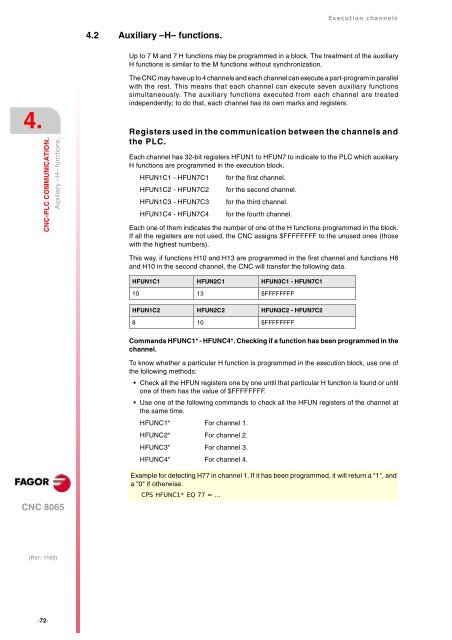EN: man_8065_chn.pdf - Fagor Automation
EN: man_8065_chn.pdf - Fagor Automation
EN: man_8065_chn.pdf - Fagor Automation
You also want an ePaper? Increase the reach of your titles
YUMPU automatically turns print PDFs into web optimized ePapers that Google loves.
4.<br />
CNC-PLC COMMUNICATION.<br />
CNC <strong>8065</strong><br />
(REF: 1103)<br />
·72·<br />
Auxiliary –H– functions.<br />
4.2 Auxiliary –H– functions.<br />
Execution channels<br />
Up to 7 M and 7 H functions may be programmed in a block. The treatment of the auxiliary<br />
H functions is similar to the M functions without synchronization.<br />
The CNC may have up to 4 channels and each channel can execute a part-program in parallel<br />
with the rest. This means that each channel can execute seven auxiliary functions<br />
simultaneously. The auxiliary functions executed from each channel are treated<br />
independently; to do that, each channel has its own marks and registers.<br />
Registers used in the communication between the channels and<br />
the PLC.<br />
Each channel has 32-bit registers HFUN1 to HFUN7 to indicate to the PLC which auxiliary<br />
H functions are programmed in the execution block.<br />
HFUN1C1 - HFUN7C1 for the first channel.<br />
HFUN1C2 - HFUN7C2 for the second channel.<br />
HFUN1C3 - HFUN7C3 for the third channel.<br />
HFUN1C4 - HFUN7C4 for the fourth channel.<br />
Each one of them indicates the number of one of the H functions programmed in the block.<br />
If all the registers are not used, the CNC assigns $FFFFFFFF to the unused ones (those<br />
with the highest numbers).<br />
This way, if functions H10 and H13 are programmed in the first channel and functions H8<br />
and H10 in the second channel, the CNC will transfer the following data.<br />
HFUN1C1 HFUN2C1 HFUN3C1 - HFUN7C1<br />
10 13 $FFFFFFFF<br />
HFUN1C2 HFUN2C2 HFUN3C2 - HFUN7C2<br />
8 10 $FFFFFFFF<br />
Com<strong>man</strong>ds HFUNC1* - HFUNC4*. Checking if a function has been programmed in the<br />
channel.<br />
To know whether a particular H function is programmed in the execution block, use one of<br />
the following methods:<br />
Check all the HFUN registers one by one until that particular H function is found or until<br />
one of them has the value of $FFFFFFFF.<br />
Use one of the following com<strong>man</strong>ds to check all the HFUN registers of the channel at<br />
the same time.<br />
HFUNC1* For channel 1.<br />
HFUNC2* For channel 2.<br />
HFUNC3* For channel 3.<br />
HFUNC4* For channel 4.<br />
Example for detecting H77 in channel 1. If it has been programmed, it will return a "1", and<br />
a "0" if otherwise.<br />
CPS HFUNC1* EQ 77 = ...
















